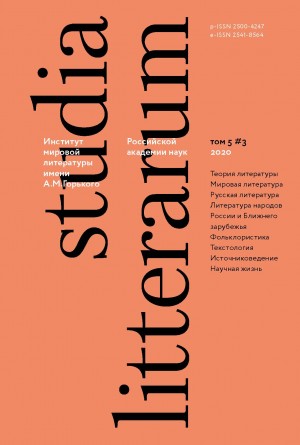Two Wooers and their Sonnets: On Poetic Forms in Romeo and Juliet
Journal title: Studia Litterarum
Authors: E.V. Haltrin-Khalturina
Subject(s): Literature, Languages and Literature

Journal title: Studia Litterarum
Authors: E.V. Haltrin-Khalturina
Subject(s): Literature, Languages and Literature
Journal title: Studia Litterarum
Authors: V.M. Tolmatchoff
Subject(s): Literature, Languages and Literature
Journal title: Studia Litterarum
Authors: A.V. Golubtsova
Subject(s): Literature, Languages and Literature
Journal title: Studia Litterarum
Authors: Z. Kalavszky
Subject(s): Literature, Languages and Literature
Journal title: Studia Litterarum
Authors: E.А. Stetsenko
Subject(s): Literature, Languages and Literature
Journal title: Studia Litterarum
Authors: M. Ljunggren
Subject(s): Literature, Languages and Literature
Journal title: Studia Litterarum
Authors: M.Yu. Ignatieva (Oganisyan)
Subject(s): Literature, Languages and Literature
Journal title: Studia Litterarum
Authors: D.S. Moskovskaya
Subject(s): Literature, Languages and Literature
Journal title: Studia Litterarum
Authors: M.L. Fyodorov
Subject(s): Literature, Languages and Literature
Journal title: Studia Litterarum
Authors: Yu.Y. Barabash
Subject(s): Literature, Languages and Literature
Journal title: Studia Litterarum
Authors: E.A. Samodelova
Subject(s): Literature, Languages and Literature
Journal title: Studia Litterarum
Authors: V.А. Rezvy
Subject(s): Literature, Languages and Literature
Journal title: Studia Litterarum
Authors: M.V. Skorokhodov
Subject(s): Literature, Languages and Literature
Journal title: Studia Litterarum
Authors: T.Nicolescu
Subject(s): Literature, Languages and Literature
Journal title: Studia Litterarum
Authors: Z.S. Zakruzhnaya
Subject(s): Literature, Languages and Literature